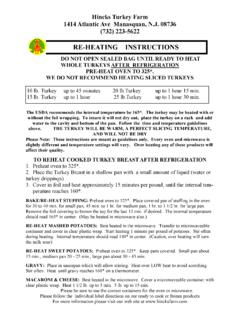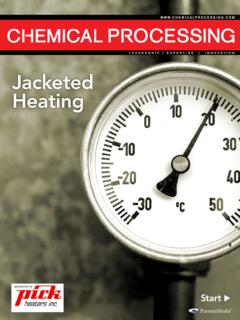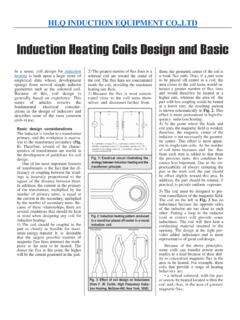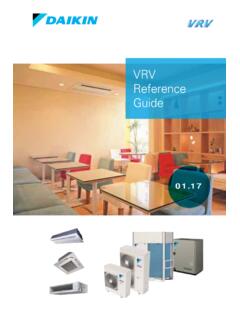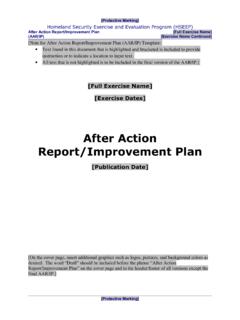Transcription of LIHEAP Funds for Furnace Repair and Replacement
1 Using Crisis and Weatherization Funds to Address Equipment Needs C onsidering LIHEAP s emphasis on assisting eligible low-income households meet their energy needs, it s not surprising that the program s authorizing statute allows Funds to be used for ener-gy-related home Repair . Known as Assurance One, Section 2605(b)(1)(C) states LIHEAP funding can be used to provide low-cost residential weatheriza-tion and other cost-effective energy-related home Functioning home energy systems, in-cluding furnaces, form the basic structural compo-nent for households to meet their heating needs, which is why many LIHEAP grantees offer Repair and/or Replacement .
2 Because the statute refers to home Repair in the context of weatherization, the majority of state grantees check off in their annual plans that they provide Furnace Repair / Replacement as a low-income weatherization (LIWAP) service. However, some grantees also incorporate Furnace Repair / Replacement into their crisis programs, realizing that losing a heating system puts low-income house-holds at risk. Generally, there are three ways that grantees run their Furnace Repair / Replacement services: as part of their LIWAP component; as part of their crisis component; or as a combination of LIWAP and crisis.
3 This issue brief looks at these three op-tions primarily by examining grantees annual plans for Fiscal Year 2014. Furnace Repair / Replacement and LIWAP The LIHEAP statute limits the amount of fund-ing that can go towards LIWAP to 15 percent of a grantee s allotment, unless a waiver is obtained from the Department of Health and Human Services which allows spending up to 25 percent. The vast majority of state grantees indicated in their Fiscal Year 2014 plans that they offered Furnace re-pair/ Replacement service as part of their LIWAP component (see the table on page 2 for more infor-Issue Brief B a n n e r SEPTEMBER2014 Issue Brief #6 LIHEAP Funds for Furnace Repair and Replacement FY 2014 HEARTWAP Program Guidance, Massa-chusetts Department of Housing and Community Development/Division of Community Resources, Oct.)
4 1, 2013 Home Furnace Repair Program, Energy Outreach Colorado heating Equipment Vendor Agreement, New York Office of Temporary and Disability Assistance, September 2012 Packet for Prospective Furnace Repair Contrac-tors, Community and Economic Development Asso-ciation of Cook County, February 2014 ERR Furnace Replacement Inspection Tool, Minne-sota Department of Commerce, Program Year 2014 Home Energy Plus Furnace Program Manual, Wis-consin Division of Energy Services, Fiscal Year 2014 LIHEAP Crisis Components: Requirements, Varia-tions, Innovations, LIHEAP Clearinghouse, May 2014 Fiscal Year 2014 State Plans, LIHEAP Clearing-house Fiscal Year 2014 Tribal Plans, LIHEAP Clearing-house Furnace Repair / Replacement Resources safe heating systems.
5 If Funds remain after the heating season, HEARTWAP continues. The program is designed to primarily serve homeown-ers with incomes up to 60 percent of the state me-dian income, and households are served based on need by the local agencies administering LIHEAP . For more information, please see the HEART-WAP manual. While Michigan mentions Furnace Repair / Replacement under both its LIWAP and crisis components, it does detail how LIWAP Funds can be spent. Included in the list of allowable services is Furnace Repair / Replacement up to $1,500. The annual plan says exceptions to the limit can be made if subgrantees deem it necessary.
6 However, the plan says supporting documentation, such as how the Furnace to be replaced presents a safety issue or how it is needed before other LIWAP services can happen, must be placed in the client s file if the $1,500 cap is exceeded. It s not unusual for grantees that run Furnace Repair / Replacement programs to focus on home-owners or make stipulations involving landlords if an applicant is a renter. The Association of Vil-lage Council Presidents in Alaska spells out such a distinction in its plan. Its Furnace Replacement program is part of its LIWAP, and the annual mation).
7 Grantees have the option of providing these services, as well as other weatherization measures, using Department of Energy Weatherization Assistance Pro-gram (WAP) rules, LIHEAP rules, or a combination of the two. The maximum amount listed in the table doesn t just apply to the Replacement of home heating or cool-ing systems. Instead, it is the total allowed for all the LIWAP measures provided for the household. Some grantees cap the expenditures on Furnace Repair / Replacement . Examples include California at $5,100 (which exceeds the LIWAP maximum average of $3,514); Michigan at $1,500; Virginia at $2,500; Ore-gon s Klamath Tribes at $1,800; and South Dakota s Oglala Sioux Tribe at $2,500.
8 Virginia s FY 2014 plan said it prioritizes LIWAP services for households that don t have a permanent, safe, and operable heat source. Many grantees indicate that they provide the re-pair/ Replacement services as part of their LIWAPs, but they don t include specifics in their plans. However, some grantees prominently feature their LIWAP fur-nace services. For example, Massachusetts offers the heating Emergency Assistance Retrofit Task Weather-ization Assistance Program, or HEARTWAP. During the heating season, the program operates as an emer-gency-based option to help homes Repair or replace un-Page 2 LIHEAP Clearinghouse Issue Brief #6 Furnace Repair and Replacement Page 2 Issue Brief Furnace Repair / Replacement and LIHEAP Weatherization Component 40 The number of states indicating Repair / Replacement service in LIWAP 4 Grantees using only LIHEAP weatherization rules 16 Grantees using only Department of Energy weatherization rules 20 Grantees using a mix of LIHEAP and DOE weatherization rules Maximum LIHEAP Benefit Weatherization
9 Expenditure Per Household Maximum/Average Benefit* States $1,000-$2,000 Iowa, Louisiana, Missouri $2,000-$4,000 California, Montana $4,000-$6,000 Arizona, Georgia, Minnesota, Tennessee, Texas $6,000-$7,000 Arkansas, Washington , Florida, Maine, Massachusetts, Michigan Missis-sippi, New Jersey, Oklahoma, Pennsylvania, South Carolina, Virginia More than $7,000 Delaware, Nevada *Note: Some annual plans listed a maximum benefit, while others listed a maximum average benefit per household Source: LIHEAP Clearinghouse review of preliminary Fiscal Year 2014 state plans Cheaper, Healthier Alternatives for Wood-Heat Clients plan says.
10 The landlord must know that it belongs to the [ LIHEAP ] recipient, not the landlord. If the recipient moves, they can take their fur-nace/ heating system with them. The Association s LIHEAP Director, Nicholas Hoover, said the language was included to make sure landlords understood the new Furnace was awarded to the LIHEAP recipient, and, contrary to some landlords impressions, it does not belong to them as part of their rental property. Hoover said the lan-guage usually ends up allowing the recipient to nego-tiate system ownership with the landlord when the rental agreement terminates or the recipient moves.
